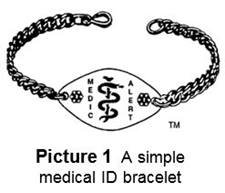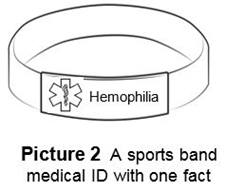Medical Identification (ID)

A medical identification (ID) is a piece of jewelry that has a medical symbol and states a health condition (Pictures 1, 2 and 3). It can be a bracelet, necklace or sports band. Some people tattoo the information on their wrists or body.
Why have a medical ID

In an emergency, the medical ID can speak for someone when he or she is not able to speak. It gives quick facts about what is most important to the person’s health so that the right care can be given right away.
Emergency health providers are trained to first look at wrists, then check the neck for a medical ID. They usually do not go into a wallet or check a cell phone for health information.
A medical ID is good for people who have:

- Allergies - food, drugs or insects
- Heart disease
- Special treatments
- Diabetes
- Blood disorders
- Transplant
- Epilepsy or seizures
- Rare diseases
- Deafness or blindness
What to choose
Medical IDs can be bought at pharmacies, online and at some jewelry stores. The choice of which one to buy should be based on what health facts are most important and what suits the person’s lifestyle.
-
Start by asking the health provider for help. What are the key medical facts someone needs to know in an emergency?
-
Is a pre-engraved ID with one diagnosis such as Hemophilia, enough (Picture 2)? If not, what other facts need to be engraved on a custom medical ID? The facts should be arranged in order of importance (Picture 3).
-
Can information on the label be abbreviated or shortened?
-
For allergies, a simple NO before the kind of allergy will be clear. Or, use ON to tell about a medicine. Some examples are:
Medical Fact
Label
Medical Fact
Label
Allergy to bees
NO BEES
Diabetes 1 Insulin
DM1-INSULIN
Allergy to latex
NO LATEX
Diabetes 1 Pump
DM1 PUMP
Allergy to nuts
NO NUTS
Do not resuscitate
DNR
Allergy to penicillin
NO PCN
Medicines
MEDS
Bone Marrow Transplant
BMT
Sickle Cell Disease
SCD
Cystic Fibrosis
CF
Type of transplant
TX - KIDNEY
Diabetes Type 1 (or 2)
DM 1
Vagus Nerve Stimulation
VNS
- There are medical diagnoses that cannot be shortened and may need to be spelled out.
-
|
Asthma |
ASTHMA |
Hemophilia |
HEMOPHILIA |
|
Blind (or deaf) |
BLIND (OR DEAF) |
On blood thinner |
ON BLOOD THINNER |
|
Epilepsy - on meds |
EPILEPSY ON MEDS |
Seizures - on meds |
SEIZURES |
- Sometimes SEE OTHER SIDE is written on the front
with facts on the back (Picture 3).

- Ask what style fits the way the person lives. Does the medical ID need to be extra strong, waterproof, fashionable or made of a certain metal?
- For privacy reasons and because paramedics will not have
time to make phone calls or check medical records online,
numbers should not be put on the medical ID:
- No telephone numbers
- No medical record numbers
- No pin numbers or log in information
A medical ID should be worn at all times. It may prevent an emergency from happening and reduce trips to the hospital. Most important, wearing a medical ID can save a life.
HH-47 2/18 Copyright 2018, Nationwide Children’s Hospital
